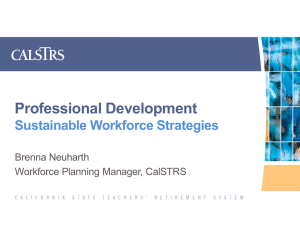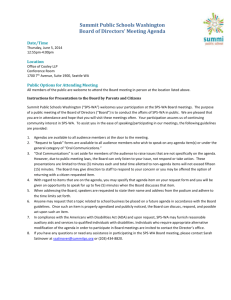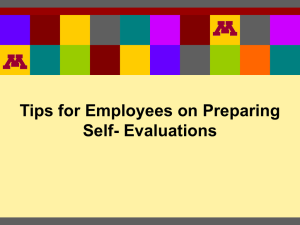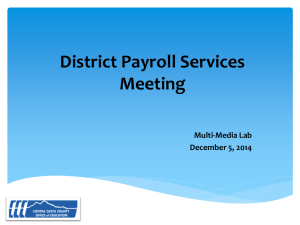- Sacramento
advertisement
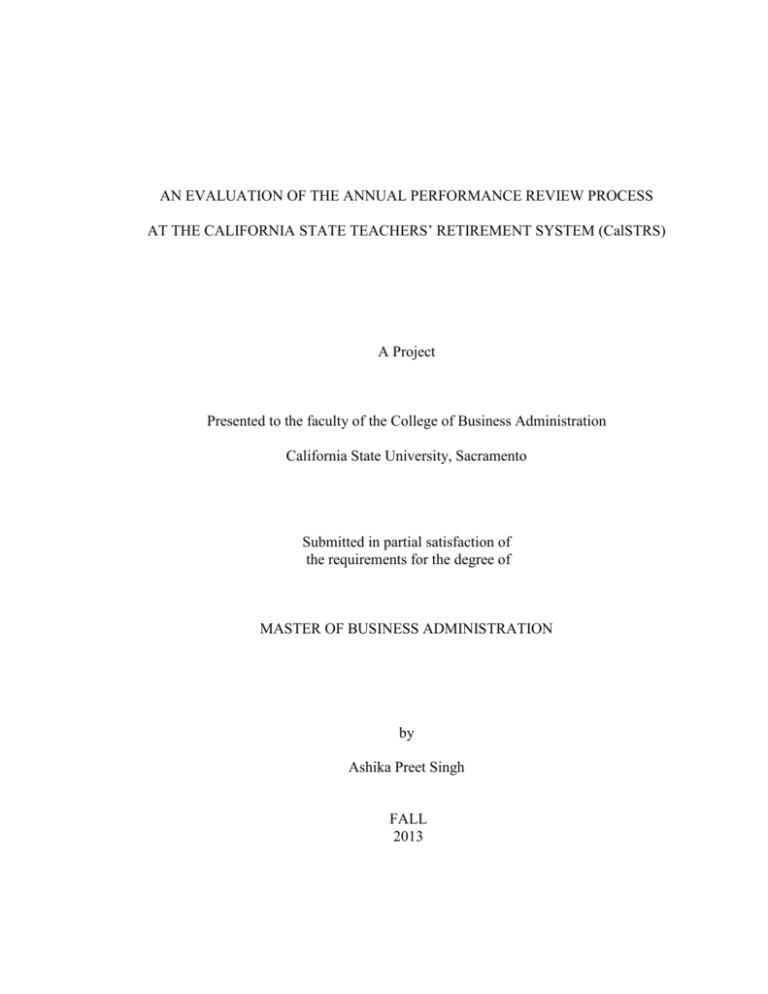
AN EVALUATION OF THE ANNUAL PERFORMANCE REVIEW PROCESS AT THE CALIFORNIA STATE TEACHERS’ RETIREMENT SYSTEM (CalSTRS) A Project Presented to the faculty of the College of Business Administration California State University, Sacramento Submitted in partial satisfaction of the requirements for the degree of MASTER OF BUSINESS ADMINISTRATION by Ashika Preet Singh FALL 2013 AN EVALUATION OF THE ANNUAL PERFORMANCE REVIEW PROCESS AT THE CALIFORNIA STATE TEACHERS’ RETIREMENT SYSTEM (CalSTRS) A Project by Ashika Preet Singh Approved by: __________________________________, Committee Chair Margaret A. Cleek, Ph.D. ____________________________ Date ii Student: Ashika Preet Singh I certify that this student has met the requirements for format contained in the University format manual, and that this project is suitable for shelving in the Library and credit is to be awarded for the Project. _____________________, Associate Dean for Graduate & External Programs _______ Monica Lam, Ph.D. Date College of Business Administration iii Abstract of AN EVALUATION OF THE ANNUAL PERFORMANCE REVIEW PROCESS AT THE CALIFORNIA STATE TEACHERS’ RETIREMENT SYSTEM (CalSTRS) by Ashika Preet Singh Statement of Problem The California State Teachers’ Retirement System (CalSTRS) is a quasigovernmental department within the State of California and has significantly improved its Human Resources operations since 2008. One of the greatest improvements, based on statistical data captured by the department’s Workforce Planning unit, is the number of Annual Performance Appraisals and Individual Development Plans that is completed and submitted each year. However, although this number has increased, the quality and purpose of the reports may not be improved upon or achieved, based on employee retention. The purpose of this project is to assist the department by providing a thorough review of the current appraisal process and identifying key gaps, in order to provide recommendations on how to close these gaps. Sources of Data In completing this project, information was retrieved from the current policies and procedures set forth by the State of California and CalSTRS, best practice research, iv various performance management related literature, and existing appraisal-related documents. Conclusions Reached By thoroughly researching and discussing the current gaps that are otherwise difficult to identify and providing recommendations on closing these gaps, the department’s employee retention would increase. The recommendations would also serve as a solid plan for employee development through the appraisal process. _______________________, Committee Chair Margaret A. Cleek, Ph.D. _______________________ Date v ACKNOWLEDGEMENTS My family has been extremely supportive through not only this process, but also my entire educational career. I would like to give special thanks to my father, Nirmal S. Sahota, and my mother, Sukhvinder K. Sahota, along with my sister, Ashley S. Bajwa, and brother-in-law, Baljinder S. Bajwa. Last but not least, my fiancé, Ricky S. Nahal has played an essential role and has always supported and motivated me. Thank you for always being there and going above and beyond to help me, no matter what the circumstances. Special Thanks To: Sahota, Johal, Dhanoa, and Nahal families CalSTRS Human Resources Management and Staff Dr. Margaret A. Cleek, College of Business Administration vi TABLE OF CONTENTS Page Acknowledgements ..................................................................................................... vi Chapter 1. INTRODUCTION .................................................................................................. 1 2. BACKGROUND .................................................................................................... 3 Agency Setting .................................................................................................. 3 CalSTRS’ Performance Review Process .......................................................... 6 Literature Review.............................................................................................11 3. ANALYSIS AND RECOMMENDATIONS ....................................................... 17 A Proactive Approach ..................................................................................... 18 360-Degree Approach ......................................................................................19 4. CONCLUSION ..................................................................................................... 24 References ................................................................................................................... 25 vii 1 Chapter 1 INTRODUCTION In 2007, the Human Resources (HR) division within the California State Teachers’ Retirement System (CalSTRS) was not entirely running as a fully functioning HR office. Specifically, positions were not being tracked appropriately, and thus, position numbers were being assigned to more than one incumbent, which understandingly, caused budgetary and transactional frustrations and confusions within the department. Furthermore, due to unknown reasons, the retention of staff within the HR division was steadily declining. It was not until 2008 that a new HR leadership team was hired, which included a new Director over the entire division and an experienced manager over Personnel Services. Changes were soon after implemented in an attempt to reorganize the many HR processes for better efficiency and tracking, which quickly transformed the office into a more fully functioning one. Such changes turned around the operations of the division, and a positive impact was apparent throughout the entire department, as the employees and leaders of other divisions started to depend on HR, rather than discount it or be frustrated with it. This alone was a big accomplishment and the beginning of a new phase of improvements. One of the major improvements that the office made included the increase in number of Annual Performance Reviews (APR) and Individual Development Plans (IDP) that were completed and submitted each year by managers and employees throughout the organization. However, although this number has increased, the quality of the reports may have been overlooked and thus the purpose of them may not actually be achieved. 2 This could possibly be due to the fact that rather than focusing on the quality of the reports, many employees and managers may be only focusing on the quantity of reports that are actually completed, in an attempt to meet the quantitative goals on their balanced scorecards, which are visible to the entire department. Thus, the primary purpose of this project is to assist the department by providing a thorough review of the current appraisal process, along with best practice research, in order to identify key gaps that may be prohibiting the department from realizing the purpose and value of the of the appraisal process, and to provide recommendations on how to close these gaps. The recommendations focus primarily on the actual process and cycle of the reviews in an attempt to create value around them within all levels of rank-and-file employees and management. 3 Chapter 2 BACKGROUND To complete a review of APR and IDP processes, the past and current processes at CalSTRS were researched, and current staff and management within CalSTRS’ HR office were interviewed, specifically individuals who were present throughout the changes that impacted the APR and IDP processes. Extensive best practice research for performance reviews was also conducted. This information, along with extensive review of APRs and IDPs for the past two years, experience as a Personnel Analyst within CalSTRS’ HR office, and information & skills learned throughout the Masters of Business Administration (MBA) program, collectively formed the knowledge base for the analysis. The terms performance review and performance appraisal are used interchangeably throughout this project. Agency Setting CalSTRS background. The California State Teachers' Retirement System has been serving California’s educators and their families since 1913. Their customer base today includes 856,000 individuals from 1,600 school districts, county offices of education and community college districts. CalSTRS is the largest educator-only pension fund in the world, and the second largest pension fund in the United States. With an impressive portfolio valued at $165.8 billion as of June 30, 2013, CalSTRS administers a hybrid retirement system that includes the traditional defined benefit, cash balance and voluntary defined contribution plans, as well as disability and survivor benefits. Being a top pension fund in the United States and the world, CalSTRS is also a 4 top employer of choice in the Sacramento area, as the department has also implemented an employee recognition program known as Virtuosity. This program received the 2012 Best Practice Standards Award for Best Overall Recognition Program from Recognition Professionals International, an organization that celebrates employee recognition, which enhances organizational performance. Receiving this type of recognition for its impressive program confirms CalSTRS’ commitment to employee satisfaction and being an employer of choice. As a state agency, CalSTRS must abide by the laws, rules, policies, and procedures set forth by the California Department of Human Resources (CalHR) – formerly known as the State Personnel Board (SPB) and the Department of Personnel Administration (DPA). One of the components of the HR processes required by CalHR includes the Annual Performance Review (APR) process and Individual Development Plan (IDP) process, which are to be completed once for every fiscal year. All state agencies must complete these documents; however, the actual processes may be tailored to fit the needs of particular departments. For instance, the California Department of Corrections and Rehabilitation (CDCR) would not use the same performance factors for Correctional Officers as another department would for Office Assistants. In 2008, however, CalSTRS was one of the many departments who did not actively complete these documents or track them to ensure that these documents were (1) being completed and (2) being completed in a timely manner. It was not until the Workforce Planning Unit within the Personnel Services Division was formed, that focus shifted towards APRs and IDPs. This unit works to 5 ensure that the unit meets organizational objectives by aligning the needs of the organization and employees. Although this was a big accomplishment, the next step would be to focus on the quality of the reports and having the ability to check back on the development of employees to verify if the reports are, in fact, helping to professionally develop employees, which is the primary intention of completing them. Core Values. CalSTRS is an agency that has adopted core values, which are embedded in the company culture and promoted throughout the organization. Specifically, CalSTRS’ Core Values are a set of attitudes, beliefs and behaviors that define the organization and its employees. The seven values are ordered to spell out ‘CalSTRS’ and include the following: Customer Service, Accountability, Leadership, Strength, Trust, Respect, and Stewardship. Core Competencies. In addition to these core values, CalSTRS employees are also expected to work by the core competencies set forth by the department. These Core Competencies include the knowledge, skills, abilities, and behavioral characteristics that are essential for the success of employee’s within the organization. The core competencies apply to all employees, at every level and across all branches within the organization, and were developed in alignment with CalSTRS’ Vision, Mission, Organizational Values, and Four Organizational Goals. The competencies include the following: Adaptability/Flexibility, Communication, Customer/Client Focus, Teamwork, and Work Standards/Quality Orientation. 6 CalSTRS’ Performance Review Process Enhancements to Performance Review Process. Although the organization started to better track performance reviews and probation reports in 2008, it was not until 2010 that the Workforce Planning unit started researching best practices in performance management. Collectively with Bargaining Units and the Department of Personnel Administration, they completed an examination of the performance review forms that the department was utilizing at that time and recommended changes for improvement, in an attempt to improve performance feedback by making it more timely, positive and meaningful. The primary purpose of these changes was to give employees a better understanding of their roles in the organization, to focus on their development for success, and to provide them with consistent and clear goals, as a framework for selfevaluation and self-monitoring throughout each review cycle. Effective July 1, 2012, the following changes to the performance factors took place: (1) Performance factors were aligned for consistent performance expectations and measurement; (2) CalSTRS Core Values and Competencies were fully integrated for meaningful performance measurement to support organizational culture and staff development; and (3) new forms were introduced organized by classification families. In terms of the third change, prior to these changes being implemented, there were only two separate forms to be used. One was for individuals in leadership positions, and a second one for staff. After this change, however, the leadership forms were separated into forms for Leader 1, Leader 2, Directors, and Executive, along with new forms being introduced for classifications with the Investments Branch. The Investment Branch forms included 7 those for Investment Officer III’s, Portfolio Managers, and Investment Directors, because these performance appraisals were directly tied into their compensation packages. The remaining Investments staff used the regular staff APR forms. With this change in place, the organization went from having two basic forms to having eight forms, each tailored to the type of position. An additional change occurred with the rating scales. The forms formerly used both five- and seven-point rating scales, where the five-point scale was only used for managers and seven-point scales was used for Directors and Executives. The changes called for using the seven-point scale for all leadership forms to allow accuracy in rating and alignment at all leadership levels. In the five-point scale, the ratings included: (1) Under Performance, (2) Marginal Performance, (3) Good Performance, (4) Great Performance, and (5) Excellent Performance. In the seven-point scale, the ratings included: (1) Under Performance, (2) Development Required, (3) Capable, (4) Competent, (5) Proficient, (6) Role Model, and (7) Exemplary Role Model (CalSTRS’ Annual Performance Review Changes). The adoption of the seven-point scale for all leadership evaluations allowed for consistent ratings across the board. Additionally, CalSTRS’ Core Values and Core Competencies were integrated to make the forms more CalSTRS specific. Since all employees and managers are expected to display the core values and core competencies that they are trained on and that are displayed throughout the building, it was beneficial to everyone to include these concepts as part of the performance factors. By doing so, this provided a way for managers to rate employees on their performance relating to the values and competencies. This is also a 8 motivator for employees to abide by the values and competencies and will also bring more value and saliency to the concepts, which could otherwise be devalued if ignored or rarely referred to in ongoing activities. Training and Communications. Implementing such changes require ample communication and training to everyone involved, which essentially constitutes the entire organization. In an organization of over 900-employees, it can be difficult to not only communicate the changes, but also provide enough information so that the changes are effectively understood. Fortunately, the Workforce Planning Unit was able to successfully do this by utilizing various methods. These methods included making an announcement on CalSTRS’ intranet, titled Central, which is accessible by every individual within the organization when logged on to the CalSTRS network, and additionally, providing Frequently Asked Questions (FAQs), which detailed the changes and provided answers to any questions that may arise in response to the changes. Further, an email communication went out to the CalSTRS Leadership team, and flyers were posted throughout the building, mainly in core break areas where there is a lot of traffic throughout the day and the chances of reaching a larger audience were higher. Along with the flyers, updates were listed on video monitors throughout the building, which are also near the elevators so those who go in and out of the building could easily and quickly view the communication. Lastly, the HR Executive presented all of the changes at a Quarterly Performance Review (QPR) meeting. In addition to the various forms of communication that were utilized, training courses were also delivered to employees and managers. Various sessions were provided, 9 and continue to be conducted, by the HR Training Unit and also an HR representative to answer any clarifying or performance related questions. The course was offered at various times and attendance, although not mandatory, is highly recommended because a majority of the information that should be communicated with staff is in this course. During the course, each participant receives a staff guide titled “Professional Development: A Core Competency Approach,” which provides information regarding the core competencies, APR and IDP processes, along with understanding the importance of such documents. It also focuses on answering what retention, development, and performance is, and is one of the many attempts made by the Workforce Planning Unit to educate CalSTRS’ employees and management on the appraisal and development processes. Process of APRs and IDPs. The annual performance cycle at CalSTRS is based on the fiscal year period, beginning on July 1st and ending on the following June 30th. The process consists of a Performance Review based on the preceding year and a Development Plan to address areas of improvement or targeted development to achieve employee career goals and specific business goals. Managers and employees are expected to meet and discuss the ratings that the manager would give the employee, and the ratings that the employee would give to himself/herself. The purpose of this discussion is to create an open environment where each individual feels comfortable sharing information, with the same goal in mind: to recognize successes and help to strengthen any potential weaknesses. Although both parties have the ability to discuss the ratings, the final performance review is completed by the manager and submitted to the HR office. 10 However, in the instance that an employee does not agree with the performance ratings that he/she received, then he/she has the ability to submit a rebuttal report directly to HR. In addition to the APR documents, staff must also complete IDP’s that specifically list out the goals that he/she has for the next fiscal year and the ways in which he/she intends to meet those goals. For instance, a staff person may be interested in strengthening his/her current public speaking skills. He/she would therefore list that as the goal and state to “enroll and actively participate in CalSTRS’ Toastmasters Club” as the method to reach his/her goal. It is the manager’s responsibility to frequently check in with the employee throughout the year to ensure that he or she has the necessary tools in order to succeed in the goals listed as part of the development plan for that year. Once the documents are received in the HR office, they are tracked and reviewed by a Personnel Analyst who reads the reviews and flags any potential performance issues that may need further attention. If a performance issue seems apparent, the Personnel Analyst contacts the manager to provide assistance in the form of progressive discipline. In the CalSTRS APR/IDP Instructions, a detailed timeline is shared, including information on the following: Review Period, Discussion Period, Submission Date, Extension, and Exception. The review period is from July 1st until June 30th of the preceding fiscal year and only performance that takes place during this timeframe is to be discussed and documented. Next is the discussion period, which is done annually from July 1st until early September. This is the period where managers conduct APR discussions and prepare development plans for signatures and routing. Following the discussion period is the submission date, which is September 30th of every year. This is 11 the date that all final required forms are due to HR. Any extensions and exceptions are to be pre-approved by HR prior to the September 30th deadline and these extensions and exceptions are considered on a case-by-case basis. Literature Review Performance appraisals. Performance appraisals can be known to many as performance reviews or evaluations. No matter what term is used, however, the overall concept remains the same. Performance appraisals were first intended to focus primarily on punishing employees for poor performance as a means for motivating them to achieve higher performance standards. Although a part of this idea remains true, it has since dramatically transformed into a more positive process that allows for open feedback and constructive criticism, in an attempt to better develop the employee. According to Dessler, a performance appraisal can be referred to as 1) an instrument or form to assess an employee’s job performance; 2) an interview where an employee’s job performance is assessed and feedback is given to the employee; 3) a system of setting employee job expectations/employee actual job performance/assessing that performance/feedback to the employee on the performance assessment and how to improve it in the future/setting new goals and expectations for another period; or 4) performance management with job performance appraisal a part of it (Dessler 2001). In simple terms, however, a performance appraisal “is the evaluation of a person’s performance [and] gives employees feedback on performance, identifies their developmental needs, and influences promotion, demotion, termination, selection and placement decisions” (Nelson and Quick 98). 12 Performance appraisals or reviews can be completed in many different ways, both formally and informally. The most common methods include Rating Scales, which are used at CalSTRS, the Management by Objectives (MBO) method, and 360-Degree Feedback. The Rating Scale method is a performance appraisal method in which the manager rates the employee’s performance on a continuum. The ratings can be on a scale relating the number 1 to “poor performance” and the number 5 to “excellent performance.” Departments or organizations that utilize this method have already identified which rating would qualify an employee to receive a bonus or a demotion/dismissal. Therefore, these clear ratings work as motivators to employees to at least meet the expectations or exceed them; otherwise, they may face the negative consequences of demotion or dismissal, depending on the rules of the organization where they are employed. In addition to the Rating Scale method, Management by Objectives can be defined as “a goal-setting program based on interaction and negotiation between employees and managers (Nelson and Quick 97). It was developed by Peter Drucker over fifty years ago and the first step of the process includes a statement from the employee explaining the employee’s understandings of the nature of the job and specific goals or objectives that he/she would like to set for the next few months or year. This statement or letter is then discussed between the employee and manager and together, they develop a finalized performance plan for the employee to work from for the next performance period and defines the resources the manager must provide to support the employee. 13 Lastly, the 360-degree performance method is a more extensive process in which many individuals are involved, other than the employee and manager, in an attempt to create a more accurate review. It “provides a well-rounded view of performance from superiors, peers, followers, and customers” (Nelson and Quick 100). This method, although more accurate and pleasurable, requires more time commitment from all individuals involved; therefore, it is oftentimes up to the department as to whether or not such a method would work well within their system. Importance of Performance Reviews/Appraisals. Performance appraisals, although time-consuming and sometimes painstaking tasks, are vital to the success of companies and of employees, as they have “more influence on individual careers and work lives than any other management process” (Kondrasuk 57) does. Thus, having an appraisal system in place helps leaders in organizations to identify the ways in which employee performance can be improved upon, and also celebrate individual achievements. This allows employees to begin to feel that they are important and that their roles have an impact on the overall well being of the company. Additionally, performance appraisals offer feedback to employees in an attempt to help them enhance their performance, which benefits the employee, the manager, and the organization. There are oftentimes instances in the workplace where managers do not have open communication with employees, which inhibits open feedback, and can further negatively impact the employees’ perceptions of their jobs. They may feel that they are not valuable employees and lack the skills to do well and be recognized, or they may feel that their qualifications are best suited for positions in which they can further develop 14 themselves. In each of these instances, many organizations begin to see a higher rate of turnover. Turnover, according to Adrian Gostick and Chester Elton in “The Invisible Employee” is “costly [and] by far the largest uncalculated expense in the corporate world” (Gostick and Elton, 34). Therefore, it would be beneficial to not only the organization, but also for mangers and employees to avoid such large turnover rates, which could negatively impact the organization’s financial stability and the employees’ future careers. By completing high quality performance appraisals and following up on development plans, organizations can avoid such high turnover rates. Additionally, failure to complete these performance reviews may cause employees to become what are known as “invisible employees.” These employees feel “over-looked, ignored and unappreciated [and] fight back the only way they know how,” which is to stay hidden (Gostick and Elton 7). It is important to keep these individuals satisfied for long-term engagement, which not only benefits they employees but also benefits the organization as a whole because turnover, itself, is very costly. Therefore, it is important to focus on how to keep employees engaged and satisfied for long-term results. Some ways that Gostick and Elton suggest are to set a guiding vision, actively see employee achievements that move the organization toward its goal, and celebrate those achievements. One way to do this is by completing performance reviews with employees; however, these reviews can sometimes be difficult to complete. The next section will cover the key characteristics of an effective appraisal system. Key Characteristics of an Effective Appraisal System. Understanding the importance of Performance Reviews/Appraisals is important, however, having an 15 understanding of an effective appraisal is even more critical. According to Nelson and Quick, managers must consider five key characteristics of effective performance appraisals, which include validity, reliability, responsiveness, flexibility, and equitability (Nelson and Quick 101). Validity refers to the accuracy of an employee’s performance. This is especially important for an employee’s current job and future careers, as it can create tension between the manager and employee if inaccurately rated, and can also hinder any potential future promotional opportunities. Branching off of validity is the idea of reliability. In terms of performance appraisals, one type of reliability refers to collecting evaluations throughout the entire evaluation period and from multiple sources. By doing so, managers can increase the chances of having an accurate report that is true to the employees performance throughout that performance period. The next key characteristic is responsiveness and this refers to allowing the employee to have input in the review process and being responsive to his/her thoughts. Next is flexibility, which also branches off of the last key characteristic because not only is it important to allow the employee to have feedback to the rating, but it is also important to stay open to modifying the ratings. The last key characteristic is equitability, which is extremely important because managers must rate each individual fairly and equally. In other words, there cannot be any bias when completing such reports, as they must only be based on job performance, not on non-performance related differences amongst individuals. An additional idea to keep in mind is goal setting, which is the “process of establishing desired results that guide and direct behavior” (ORGB 95). Goals provide many benefits within the workplace because they increase work motivation and task 16 performance, reduce role stress, conflict, and ambiguity, and also improve performance evaluations. The key characteristics of an appraisal system and the idea of goal setting both can be related to the aforementioned methods of performance appraisals. 17 CHAPTER 3 ANALYSIS AND RECOMMENDATIONS After researching CalSTRS’ agency setting and the departments current APR process, along with literature review, it is apparent that this department prides itself in developing its employees. With the help of the Workforce Planning Unit and support of staff and management throughout the organization, CalSTRS has made many advancements in the APR and IDP processes. There are abundant resources easily available for staff and management at all levels, which may not be the case in other departments. Additionally, the training course that is provided to everyone is one of the best advancements made within the organization and this step is commendable. By implementing an APR and IDP process, the organization is providing a yearly progress report for employees, while letting them know how well they are doing their jobs and helping them realign their efforts. These processes not only provide feedback to employees, but also allow managers to make careful analysis of the employee’s work and assign work that is to the best advantage of the employee and the organization. The processes also allow managers to determine the additional training needs of the employee, prepare the employee for current and future business needs, and manage and improve organizational performance through direct feedback for each employee. Although CalSTRS already has a performance appraisal process in place, there is definitely room for improvement. Based on the research performed on performance appraisals and on CalSTRS’ process, it is highly recommended that the department take a more proactive approach and also utilize the SharePoint system in order to implement the 18 360-degree feedback method. A proactive approach. The performance review period is based on the fiscal year, starting from July 1st and ending on June 30th of the following year. Staff and management then have until September 30th to complete and submit all of the necessary documentation to close out the review process for that year. In terms of updates and information that is dispersed throughout the department, communication usually goes out in June and July, which is the very ending of the review period. Therefore, it would be beneficial for the Workforce Planning Unit, in conjunction with Personnel Services and Training Services, to continue to train throughout the performance period and continue to educate, rather than doing so one time of the year. Additionally, it is important for staff and management to understand that this is a yearlong process. Although the formal paperwork is only completed once a year, the actual process of managing performance and the development goals that were set forth the last period cycle is an ongoing process. Therefore, having weekly, bimonthly or monthly check-ins may be important for managers to consider. During these meetings, managers can communicate any concerns that they have with the employee’s performance or recognize any achievements. Also at this time, both managers and employees can discuss the goals that they collectively set for the year and determine whether more resources are required, or if the goals have already been met. All in all, it is critical for all employees and leaders to understand that the performance period is an entire year and that everyone should be actively thinking about it throughout the year in order to enhance the quality of the APR and IDP processes. 19 360-Degree Approach. CalSTRS has a solid performance appraisal and development process in place and is more advanced than other state agencies in the sense that the forms have been updated to reflect the organization’s core values and core competencies, along with customization for levels of leadership or special classifications. Additionally, many branches throughout the organization are submitting the APR and IDP forms at a rate of 100%; however, it is important for the organization to now consider how to enhance the quality of these reports. The department recently introduced Microsoft’s SharePoint, which allows you to share, organize, discover, build, and manage information within the department (SharePoint, 2013). Many of the divisions at CalSTRS have already started utilizing SharePoint as a way to share information as low as the team level, and as high as the entire organizational level. Having information saved, and also having the ability to set privacy restrictions, allows the individuals in a certain team to save their work in a central location so in the event of an unexpected absence and critical deadline, the remaining team members can access the work and appropriate information, and complete the task at hand. Considering the benefits of the 360-degree method of performance reviews and the available technology through Microsoft SharePoint, it is highly recommended that the department consider utilizing the software in order to implement a performance appraisal process in which designated individuals can save information for certain employees and managers regarding their performance throughout the performance period. By doing so, at the end of the performance period, the manager of the individual being rated will have 20 all of the information at hand that others have shared regarding the individual’s performance throughout the year, thus helping to create more accurate and better quality reviews. Implementing such a process will require preparation and extensive communication throughout the department, as it is essentially a new method that has not been previously utilized by CalSTRS. Additionally, it will be critical to first receive the approval of the executive team in order to implement the process. Therefore, the following includes a timeline of events that must occur in order to successfully complete this implementation. First, we must research and document the limitations within SharePoint, if any, in terms of creating such a process within the system. Because SharePoint is known as collaboration software, there are no real limitations to consider, as there are already functions available for use. In the case of creating private files for each employee and restrictions as to who can rate each individual, we can easily do so by utilizing the OneNote Notebook application, where you can collectively capture notes within teammates. In this case, teammates relates to the direct manager, level-two manager, and other teammates or managers that the employee works with throughout the performance period. One challenge, however, will be to ensure that the information is kept confidential. In other words, raters should only be able to see their own feedback or submissions on an individual and not be able to view all of the feedback submitted for a particular employee. All of the feedback must solely be restricted to the direct manager. Secondly, we must present the information to the Executive Team for approval. 21 The Executive Team must receive all of the pertinent information regarding the new process, including the advantages and any potential disadvantages to implementing such a process. In terms of advantages, by allowing more feedback from individuals who work with a particular employee, we can bring more value to our performance reviews. Employees oftentimes work with one another and with other managers throughout the department and may receive positive feedback, which is not always shared with management. Additionally, although CalSTRS has the Virtuosity Recognition Program in place, there are certain staff members and management who utilize it more frequently than others. Thus, the employees who come in contact with these individuals may receive more kudos than the employees who come in contact with individuals who rarely utilize the program. Therefore, using the number of recognitions received throughout the year is not the only factor to consider, as it does not clearly articulate the individual’s performance while working with individuals throughout the department. Additionally, having a 360-degree review process in place will also assist in the development of employees. Through feedback, managers may be able to view the strengths that their employees have that the managers were not aware of, along with any potential weaknesses, and can use that information to assign certain tasks to the employee in an attempt to promote the strength or strengthen the weakness. An additional advantage to implementing such a system is that the software required is already utilized by the department; therefore, there is no significant cost related to the implementation and it is essentially utilizing more functions within the software that is already available for use. Although there are many advantages to adopting such a system, there is also a 22 disadvantage that must be considered prior to implementation. With a 360-degree review, we offer a full review to be completed on each individual, which requires more time commitment for all raters involved. However, although more time and job hours will be utilized towards submitting feedback for performance appraisals, the information is being submitted throughout the performance period and not done at one time. Therefore, the time that managers usually spend on completing reviews at the end of the year can potentially be minimized because they will have a lot more information and resources at hand in order to complete a thorough APR document. Lastly, it is critical that the new appraisal process be appropriately communicated prior to implementation. The information in the training materials and communications throughout CalSTRS’ building and intranet (Central) must be updated to include the new process. This information must be shared at least six months prior to the actual use of the system. For instance, the review period begins on July 1st of every year. Therefore, the communications must start going out the January prior to that year. This will give individuals ample time to understand the new process, while asking clarifying questions and raising any potential issues that will give Workforce Planning and Technology Services the ability to enhance prior to the roll out. In summary, by taking a proactive approach and implementing the 360-degree method to performance appraisals, the department can enhance the quality of APRs and IDPs by receiving more accurate information, in a timelier manner. By allowing other management and peers to rate employees, we are allowing for more feedback from individuals that employees come in contact with throughout the year and this creates a 23 more accurate picture of the employee’s work performance. It is oftentimes difficult for managers to recall all of the projects that their employees worked on throughout the year and all of the compliments they received. Having this process in place within SharePoint will allow them to have all of the pertinent information in one central location. Employees will be more satisfied with accurate depictions of their job performance and will therefore begin to feel more valued in the workplace, diminishing the idea of the “invisible employee.” 24 CHAPTER 4 CONCLUSION The Performance Review process can be a dreadful process within Human Resources and within all companies throughout the world. However, understanding the importance of an effective system and striving to implement a system that works for your company is vital. The significance of such a system is oftentimes overlooked due to the negative connotation associated with performance reviews, but indications are that investing in the time to thoroughly and effectively complete APRs is beneficial, and that the positive outcomes compensate for the time and effort that is required to complete them. Although the number of APRs and IDPs that the department now receives is impressive, the quality of these reports are not up to what should be the CalSTRS standards. Such an advanced state agency that constantly promotes employee development by providing all of the necessary tools that they may need, led the researcher to believe that the department should already have an effective system in place. However, after completion of this project and considering the fact that the department is still in the beginning stages of tracking the data that was previously ignored, reveals that the department is making great progress, but there is always room for improvement. Therefore, the implementation of the recommendations outlined above is an effort to enhance the established processes for further improvement. 25 REFERENCES Blanchard, K., Waghorn, T. (1997). Mission Possible: Becoming a World-Class Organization While There’s Still Time. McGraw-Hill Companies. Bradley, Tamara (2013, November 12). Associate Personnel Analyst in the Workforce Planning Unit. (A. Singh, Interviewer). California State Teachers’ Retirement System (2012). Annual Performance Review Changes FY 11-12 & 12-13. Presentation. California State Teachers’ Retirement System (2013 January). Annual Performance Review – Checklist. California State Teachers’ Retirement System (2012). Annual Performance Review / Individual Development Plan - Instructions. California State Teachers’ Retirement System. (2013 May). Annual Performance Review Tool Kit. California State Teachers’ Retirement System (2013). FAQs: New Leadership Annual Performance Review Forms. California State Teachers’ Retirement System. (2012 May). Individual Development Plan CalSTRS IDP and Performance Review Summary Form 1676. California State Teachers’ Retirement System (2013 April). Leadership Annual Performance Review and Leadership Development Plan. California State Teachers’ Retirement System (2013 April). Leadership Development Plan. 26 California State Teachers’ Retirement System. (2013). Professional Development: A Core Competency Approach. Staff Guide. Conlow, Rick. (1991). Excellence in Management: Learn how to bring out the Best in people. Crisp Publications. Gostick, A., Elton, C. (2006). The Invisible Employee: Realizing the Hidden Potential in Everyone. John Wiley & Sons, Inc. Kondrasuk, Jack N. (2011). “So What Would An Ideal Performance Appraisal Look Like?” Journal of Applied Business and Economics, Vol. 12, Issue 1, p. 57-68. Nelson, D.L., Quick, J.C. (2013, 2011). ORGB 3. Erin Joyner. Neuharth, Brenna (2013, November 1). Manager of the Workforce Planning Unit. (A. Singh, Interviewer). SharePoint. (2013). Retrieved November 1, 2013, from http://office.microsoft.com/enus/sharepoint/.
